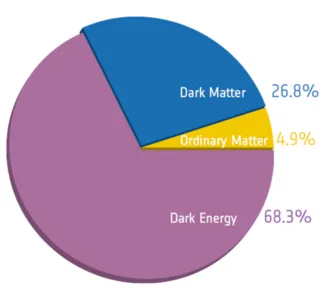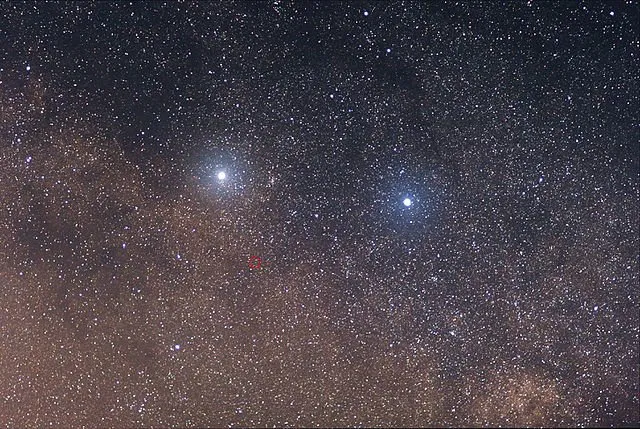One of my favorite sport on Steem is to write physics posts about what Steemians are questioning themselves about, or find interesting.
Along these lines, my attention has been recently brought to this research article, that has been published in Science.

[image credits: Wikipedia]
Just for the record, I don’t like Science much: not an open access journal…
This article discusses the organization of satellite galaxies around larger galaxies (like ours).
It demonstrates how the way in which satellite galaxies move around the larger ones is challenging standard cosmology.
THE PECULIARITY OF ANDROMEDA AND THE MILKY WAY
Our galaxy, the Milky Way, is surrounded by a bunch of satellite dwarf galaxies rotating around it, and all mostly located within a single plane. This is not new and actually known since the 1970s (see here). For instance, the Magellanic clouds are the most known examples of such dwarf galaxies, as they are visible with naked eyes.

[image credits: Wikipedia]
But is this a special feature of our galaxy?
Since about 10 years, we also know that the Andromeda galaxy features the exact same thing: it is surrounded by a bunch of dwarf galaxies, all located within a single plane.
But why is this important?
Because this structure, in which dwarf galaxies are located in a plane around a more massive galaxy, is very complicated to predict using standard cosmology.
The latter indeed predicts that dwarf galaxies are in general spread isotropically (i.e. equally in all directions) around larger galaxies.
One easy way to go around this issue is to claim that the local group, i.e. the group of galaxies containing the Milky Way and Andromeda, is special. In other words, what we have observed with Andromeda and the Milky Way consists of rare exceptions in our successful standard cosmological model.
This is where our article comes into the game. But before discussing this further, let us focus a little bit on standard cosmology.
STANDARD COSMOLOGY IN A NUTSHELL
The standard model of cosmology, that is also called the Lambda Cold Dark Matter or the ΛCDM model, is a model relying on the Big Bang hypothesis to explain how our universe works.
This model is the most minimal and simplest model that explains a plethora of properties of the universe. This includes in particular the cosmic microwave background (see for instance this post of mine), the large scale structures in the universe (see here), the light element abundance in the universe (see for instance this post of mine) and the accelerating expansion of our universe (see for instance this post of mine).

[image credits: ESA]
The ΛCDM model assumes that the universe is mostly flat, i.e. that it consists in a flat surface deformed by the objects that lie on it.
By flat, I here mean that if we draw two parallel lines (or send two laser beams) in a given direction, they will never cross.
The Lambda in ΛCDM refers to the cosmological constant. This represents dark energy, the stuff that is responsible for the accelerating expansion of the universe. As shown in the pie above, the cosmological constant is connected to almost 70% of the energy of the universe.
The second component in the energy pie of the universe concerns dark matter. It amounts to 27% of the energy budget of the universe, whose rest of it is made of visible matter (stars, galaxies and anything else).
Assuming the ΛCDM model, we can make simulations to see whether we recover the observed structures of the galaxies. And this is the intriguing fact: the satellite galaxies around the Milky Wy or Andromeda should be distributed isotropically, i.e. not all localized in a given plane.
THE CENTAURUS GROUP OF GALAXIES
In this article, the authors focus on a galaxy group located in a constellation named Centaurus, illustrated in the image below.

[image credits: Wikipedia]
For those who have heard about Proxima Centauri, the closest star to Earth after the Sun, the Centaurus constellation consists in the group of galaxies containing that star.
This group of galaxies is one of the largest cluster of galaxies close to us (but outside the local group).
It contains two subclusters: the Cen A group located around the Centaurus A galaxy, and the M83 group centered on the M83 galaxy. Yeah, great namess :p
In the considered article, the authors investigate the distributions of the galaxies around Cen A, that were earlier claimed to be distributed within two planes (and not one). However, recent observations have exhibited the presence of much more galaxies than we thought, so that their global distribution now matches better a single-planar structure, as for the Milky Way and Andromeda.
The researchers have investigated this single-planar structure and try to see, within the ΛCDM model, how it could be predicted around the three galaxies Cen A, the Milky Way and Andromeda. There are ways, but the likelihood it works is below 0.5%.
FINAL DISCUSSION
In this post, I have discussed a recent research article in which the distribution of satellite dwarf galaxies around the Milky Way, Andromeda and Cen A is studied in the context of standard cosmology. For all three cases, the satellite galaxies are organized along a single-plane, which is very unlikely to occur in standard cosmology.
For this reason, the observations now challenge standard cosmology, although the latter works extremely well for many other features of our universe. Some new puzzles to which we will hopefully get a better clue in the future…
If you also have good physics questions, dont hesitate to bug me on the steemSTEM discord server. I will be more than happy to discuss this with you!
SteemSTEM is a community-driven project that now runs on Steemit for more than a year. We seek to build a community of science lovers on Steemit and to promote well written/informative Science Technology Engineering and Mathematics (STEM) postings in order to make Steemit a place for fascinating STEM content.
More information can be found on the @steemstem blog, on our discord server and in our last project report.